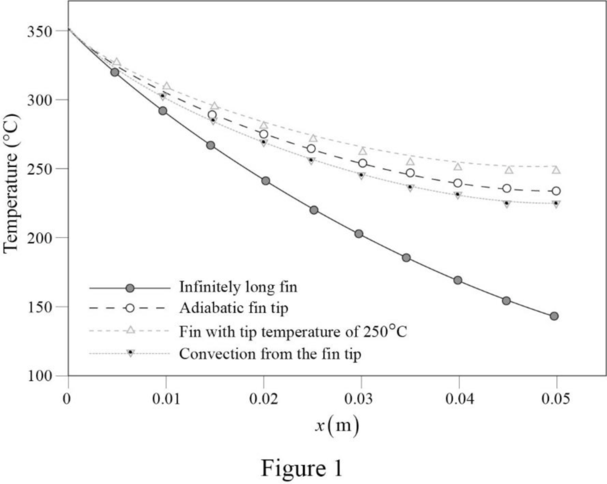
Concept explainers
(a)
The heat transfer rate for the infinitely long fin.
(a)
Explanation of Solution
Given:
Thermal conductivity of the fins
Heat transfer coefficient
Length of the fin
Diameter of the fin
Calculation:
Determine the perimeter of the circular fin.
Determine the cross section area of the circular fin.
Determine the value of m.
Determine the following factor.
Determine the heat transfer rate for an infinitely long fin.
Thus, the heat transfer rate for the infinitely long fin is
Write the expression of the temperature variation along the fin.
(b)
The heat transfer rate for the adiabatic fin tip.
(b)
Explanation of Solution
Determine the heat transfer rate for an adiabatic fin tip.
Thus, the heat transfer rate for the adiabatic fin tip is
Write the expression of the temperature variation along the fin.
(c)
The heat transfer rate for the fin with tip temperature of
(c)
Explanation of Solution
Determine the heat transfer rate for fin with tip temperature of
Thus, the heat transfer rate for the fin with tip temperature of
Write the expression of the temperature variation along the fin.
(d)
The heat transfer rate for fin with convection from the fin tip.
(d)
Explanation of Solution
Determine the heat transfer rate for fin with convection from the tip.
Thus, the heat transfer rate for fin with convection from the fin tip is
Write the expression of the temperature variation along the fin.
Tabulate the values of the temperature variation of the single fin.
|
| ||||
| Part (a) | Part (b) | Part (c) | Part (d) | |
| 0 | 350 | 350 | 350 | 350 |
| 0.005 | 318 | 326 | 328 | 325 |
| 0.01 | 290 | 305 | 308 | 304 |
| 0.015 | 264 | 288 | 292 | 285 |
| 0.02 | 241 | 272 | 279 | 270 |
| 0.025 | 220 | 260 | 268 | 256 |
| 0.03 | 201 | 250 | 259 | 246 |
| 0.035 | 184 | 242 | 253 | 237 |
| 0.04 | 169 | 237 | 250 | 231 |
| 0.045 | 155 | 233 | 249 | 227 |
| 0.05 | 142 | 232 | 250 | 224 |
Plot the temperature variation of the single fin as in Figure (1).

Want to see more full solutions like this?
Chapter 17 Solutions
Fundamentals Of Thermal-fluid Sciences In Si Units
- 1 8 4 Add numbers so that the sum of any row or column equals .30 Use only these numbers: .1.2.3.4.5.6.10.11.12.12.13.14.14arrow_forwardUppgift 2 (9p) I77777 20 kN 10 kN/m 4 [m] 2 2 Bestäm tvärkrafts- och momentdiagram för balken i figuren ovan. Extrempunkter ska anges med både läge och värde i diagrammen.arrow_forward**Problem 8-45.** The man has a mass of 60 kg and the crate has a mass of 100 kg. If the coefficient of static friction between his shoes and the ground is \( \mu_s = 0.4 \) and between the crate and the ground is \( \mu_c = 0.3 \), determine if the man is able to move the crate using the rope-and-pulley system shown. **Diagram Explanation:** The diagram illustrates a scenario where a man is attempting to pull a crate using a rope-and-pulley system. The setup is as follows: - **Crate (C):** Positioned on the ground with a rope attached. - **Rope:** Connects the crate to a pulley system and extends to the man. - **Pulley on Tree:** The rope runs over a pulley mounted on a tree which redirects the rope. - **Angles:** - The rope between the crate and tree forms a \(30^\circ\) angle with the horizontal. - The rope between the tree and the man makes a \(45^\circ\) angle with the horizontal. - **Man (A):** Pulling on the rope with the intention of moving the crate. This arrangement tests the…arrow_forward
- please solve this problems follow what the question are asking to do please show me step by steparrow_forwardplease first write the line action find the forces and them solve the problem step by steparrow_forwardplease solve this problem what the problem are asking to solve please explain step by step and give me the correct answerarrow_forward
- please help me to solve this problem step by steparrow_forwardplease help me to solve this problem and determine the stress for each point i like to be explained step by step with the correct answerarrow_forwardplease solve this problem for me the best way that you can explained to solve please show me the step how to solvearrow_forward
 Elements Of ElectromagneticsMechanical EngineeringISBN:9780190698614Author:Sadiku, Matthew N. O.Publisher:Oxford University Press
Elements Of ElectromagneticsMechanical EngineeringISBN:9780190698614Author:Sadiku, Matthew N. O.Publisher:Oxford University Press Mechanics of Materials (10th Edition)Mechanical EngineeringISBN:9780134319650Author:Russell C. HibbelerPublisher:PEARSON
Mechanics of Materials (10th Edition)Mechanical EngineeringISBN:9780134319650Author:Russell C. HibbelerPublisher:PEARSON Thermodynamics: An Engineering ApproachMechanical EngineeringISBN:9781259822674Author:Yunus A. Cengel Dr., Michael A. BolesPublisher:McGraw-Hill Education
Thermodynamics: An Engineering ApproachMechanical EngineeringISBN:9781259822674Author:Yunus A. Cengel Dr., Michael A. BolesPublisher:McGraw-Hill Education Control Systems EngineeringMechanical EngineeringISBN:9781118170519Author:Norman S. NisePublisher:WILEY
Control Systems EngineeringMechanical EngineeringISBN:9781118170519Author:Norman S. NisePublisher:WILEY Mechanics of Materials (MindTap Course List)Mechanical EngineeringISBN:9781337093347Author:Barry J. Goodno, James M. GerePublisher:Cengage Learning
Mechanics of Materials (MindTap Course List)Mechanical EngineeringISBN:9781337093347Author:Barry J. Goodno, James M. GerePublisher:Cengage Learning Engineering Mechanics: StaticsMechanical EngineeringISBN:9781118807330Author:James L. Meriam, L. G. Kraige, J. N. BoltonPublisher:WILEY
Engineering Mechanics: StaticsMechanical EngineeringISBN:9781118807330Author:James L. Meriam, L. G. Kraige, J. N. BoltonPublisher:WILEY





